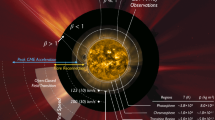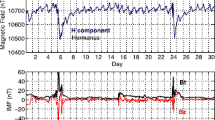Abstract
Ionospheric refractive index is especially important in the reflection and propagation of HF (3–30 MHz) waves from the ionosphere. For this reason, in this study, the relation between the real parts (μ\(_{0}^{2}\), μ\(_{x}^{2}\) and μ\(_{p}^{2}\)) of the refractive index computed as based on the direction of the Earth’s magnetic field for 300 km altitude in the equatorial ionospheric F2 region and the long-term solar indices (Sunspot Number-R12, Solar Flux at 10.7 cm -F10.7, Coronal Mass Ejection-CME) has been examined by using the multiple regression model. As a result of the examinations, it has been determined that there is a very strong relation between the three refractive index values and solar indices. While it was determined that the R12 and F10.7 indices have a very strong relation, it was also determined that CME did not have a statistically significant relation. This insignificant situation may only be explained with the magnetic field of the Earth acting like a shield.


Similar content being viewed by others
References
Tang, W., Xue, X. H., Lei, J., & Dou, X. K. (2014). Ionospheric quasi-biennial oscillation in global TEC observations. The Journal of Atmospheric and Solar-Terrestrial Physics, 107, 36–41.
Apostolov, E. M. (1985). Quasi-biennial oscillation in sunspot activity. Bulletin of the Astronomical Institutes of Czechoslovakia, 36, 97–102.
Soukharev, B. E., & Hood, L. L. (2001). Possible solar modulation of the equatorial quasi-biennial oscillation- Additional statistical evidence. Journal of Geophysical Research, 106(D14), 14855–14868.
Yiğit, E., Knížová, P. K., Georgieva, K., & Ward, W. (2016). A review of vertical coupling in the Atmosphere-Ionosphere system: Effects of waves, sudden stratospheric warmings, space weather, and of solar activity. The Journal of Atmospheric and Solar-Terrestrial Physics, 141, 1–12.
Atici, R., & Sagir, S. (2016). The Effect of QBO on foE. Advances in Space Research. https://doi.org/10.1016/j.asr.2016.10.012.
Atici, R., & Sagir, S. (2016). The effect on sporadic-E of quasi-biennial oscillation. Journal of Physics and Applications, 6(2), 10–17.
Perrone, L., & De Franceschi, G. (1998). Solar, ionospheric and geomagnetic indices. Annali di Geofisica, 41(5–6), 843–855.
Laštovicka, J., Akmaev, R. A., Beig, G., Bremer, J., & Emmert, J. T. (2006). Global change in the upper atmosphere. Science, 314(5803), 1253–1254.
Sagir, S., Atici, R., Ozcan, O., & Yüksel, N. (2015). The effect of the stratospheric QBO on the neutral density of the D region. Annales Geophysicae, 58(3), A0331.
Çetin, K., Ozcan, O., & Korlaelçi, S. (2017). The interaction between stratospheric monthly mean regional winds and sporadic-E. Chinese Physics B, 26(3), 039401. https://doi.org/10.1088/1674-1056/26/3/039401.
Liu, L., Wan, W., Chen, Y., & Le, H. (2011). Solar activity effects of the ionosphere: A brief review. Chinese Science Bulletin, 56(12), 1202–1211.
Yiğit, E., & Medvedev, A. S. (2015). Internal wave coupling processes in Earth’s atmosphere. Advances in Space Research, 55(4), 983–1003.
Al’pert, L. (1980). The direction of the group velocity of electromagnetic waves in a multicomponent magneto-active plasma in the frequency range 0 < ω<∞. The Journal of Atmospheric and Solar-Terrestrial Physics, 42, 205–216.
Budden, K. G., & Stott, G. F. (1980). Rays in magneto-ionic theory-II. The Journal of Atmospheric and Solar-Terrestrial Physics, 42, 791–800.
Hagfors, T. (1984). Electromagnetic wave propagation in a field-aligned striated cold magneto plasma with application to the ionosphere. The Journal of Atmospheric and Solar-Terrestrial Physics, 46, 211–216.
Lundborg, B., & Thide, B. (1986). Standing wave pattern of HF radio waves in the ionospheric rection regions 2. Applications. Radio Science, 21, 486–500.
Budden, K. G. (1988). The Propagation of Radio Waves (pp. 137–139). Cambridge: Cambridge University Press.
Zhang, D. Y. (1991). New method of calculating the transmission and reaection coefficients and Gelds in a magnetized plasma layer. Radio Science, 26, 1415–1418.
Aydoǧdu, M., Yeşıl, A., & Güzel, E. (2004). The group refractive indices of HF waves in the ionosphere and departure from the magnitude without collisions. The Journal of Atmospheric and Solar-Terrestrial Physics, 66(5), 343–348.
Bhawre, P., Kishore, K., Dogra, S. K., Purohit, P. K., Waheed, M. A., Khatarkar, P., et al. (2015). Characteristic of Ionospheric foF2 and Solar Indices during the 23rd Solar Cycle over High Latitude Station, Syowa, Antarctica. American Journal of Climate Change, 4(05), 408.
Laštovička, J., Solomon, S. C., & Qian, L. (2012). Trends in the neutral and ionized upper atmosphere. Space Science Reviews, 168(1–4), 113–145.
Özgüç, A., Ataç, T., & Pektaş, R. (2008). Examination of the solar cycle variation of foF2 for cycles 22 and 23. The Journal of Atmospheric and Solar-Terrestrial Physics, 70(2), 268–276.
Sagir, S., Yesil, A., Sanac, G., & Unal, I. (2014). The Charecterization of diffusion tensor for midlatitude ionospheric Plasma. Annals of Geophysics, 57(2), A0216. https://doi.org/10.4401/ag.6469.
Elias, A. G. (2014). Filtering ionosphere parameters to detect trends linked to anthropogenic effects. Earth, Planets and Space, 66(1), 1.
Chen, P. (1992). Evidence of the ionospheric response to the QBO. Geophysical Reseach Letters, 19, 1089–1092.
Yadav, S., Dabas, R. S., Das, R. M., Upadhayaya, A. K., Sarkar, S. K., & Gwal, A. K. (2011). Variation of F-region critical frequency (foF2) over equatorial and low-latitude region of the Indian zone during 19th and 20th solar cycle. Advances in Space Research, 47(1), 124–137. https://doi.org/10.1016/j.asr.2010.09.003.
Kurt, K., Yeşil, A., Sağır, S., & Atıcı, R. (2016). The Relationship of Stratospheric QBO with the Difference of Measured and Calculated NmF2. Acta Geophysics. https://doi.org/10.1515/acgeo-2016-0061.
Kutiev, I., Tsagouri, I., Perrone, L., Pancheva, D., Mukhtarov, P., Mikhailov, A., et al. (2013). Solar activity impact on the Earth’s upper atmosphere. Journal of Space Weather and Space Climate, 3, A06.
Xiao, Q., Wang, S., Zhang, Z., and Xu, J. (2015). Analysis of sunspot time series (1749–2014) by means of 0–1 test for chaos detection. In 2015 11th International Conference on Computational Intelligence and Security (CIS) (pp. 215–218). IEEE.
MacKinnon, J. G. (1996). Numerical distribution functions for unit root and cointegration tests. Journal of Applied Econometrics, 11, 601–618.
Altunç, Ö. F., & Aydin, C. (2014). An estimation of the consumption function under the permanent income hypothesis: the case of D-8 countries. Journal of Economic Cooperation & Development, 35(3), 29.
Jensen, A. B.O., Hermsmeyer, D., Huck, B., Rüffer J., and Skjellerup, P. (2011). Positioning System for the Fixed Link Across Fehmarnbelt. Accepted for GPS World.
Aydogdu, M., & Ozcan, O. (2001). The possible effects of the magnetic declination on the wave polarization coefficients at the cutoff point. Progress in Electromagnetic Research, PIER, 30, 179–190.
Author information
Authors and Affiliations
Corresponding author
Additional information
Publisher's Note
Springer Nature remains neutral with regard to jurisdictional claims in published maps and institutional affiliations.
Rights and permissions
About this article
Cite this article
Sağır, S., Yeşil, A. The Relation Between the Refractive Index of the Equatorial Ionospheric F2 Region and Long-Term Solar Indices. Wireless Pers Commun 102, 31–40 (2018). https://doi.org/10.1007/s11277-018-5823-1
Published:
Issue Date:
DOI: https://doi.org/10.1007/s11277-018-5823-1




